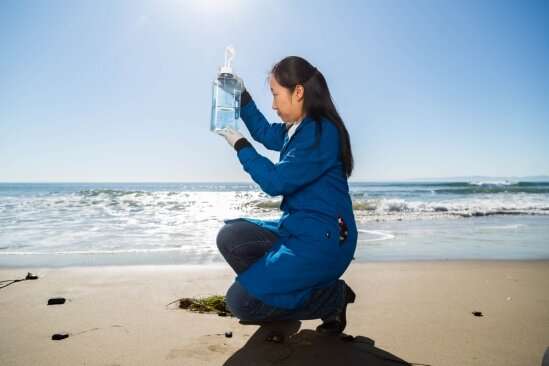Researchers connect microbes in the twilight zone of the ocean with the breakdown of tough organic molecules

Seawater is more than just saltwater. The ocean is a veritable soup of chemicals.
Part of that broth comes from dissolved carbon compounds, which account for a significant store of global carbon, on par with the amount held in the atmosphere. Researchers are actively working to classify what forms carbon takes in the world's oceans, as well as the biological processes that recycle it in the ocean's water.
Some molecules, like proteins and sugars, readily break down, while others are more resistant to degradation. A new study, led by UC Santa Barbara postdoctoral researcher Shuting Liu, investigated some of these more recalcitrant compounds and the microbes that can digest them. The results, which appear in the journal Limnology and Oceanography, illuminate basic aspects of the ocean carbon cycle and may help scientists predict the role microbes play in its regulation.
Liu and Professor Craig Carlson, in the Department of Ecology, Evolution and Marine Biology, are part of a group conducting research at the Bermuda Atlantic Time-series Study site. The site is a long-term research project in the Sargasso Sea, itself a region of the Atlantic in the vicinity of Bermuda. Over the course of many years, the scientists noticed dissolved organic matter building up in surface water during the calmer summer months. Rougher conditions in the winter mixed these compounds into deeper water, a layer scientists call the mesopelagic zone—or, the twilight zone, because spans the lowest depths that light can reach. Once that happened, some of the organic matter would break down, and the cycle would begin again. The team was eager to understand why.
To do so, Liu and her colleagues focused on carboxyl-rich alicyclic molecules, or CRAMs, a particularly tough and diverse array of organic compounds with similar chemical properties, some of which comprise the more tenacious organic molecules in the ocean.
One class of compounds that fits the CRAM description are lignins, the group of molecules that give wood its rigidity. In fact, Liu used lignin as one of four model CRAM-like compounds in her experiment.
The team's goal was simple. "We're trying to see what types of microbes are responding to these CRAM-like compounds in the mesopelagic," said Liu.
The scientists introduced their four model CRAM compounds into samples of seawater from the mesopelagic and observed the results. At various time intervals, they analyzed the concentrations of dissolved organic carbon and counted the total number of bacterial cells using a microscope. The group also used molecular probes that targeted six specific microbe lineages to determine how much each lineage was growing relative to total cell growth in the sample. This told them which of these groups were most active.
The researchers used these compounds in concentrations orders of magnitude larger than the microbes would ever see in nature. "We were taking an experimental enrichment approach," Carlson said. "If we give it to them at elevated concentrations, will they use it? And if they do use it, who's using it?"
They found that, despite the compounds' shared characteristics, their availability to the microbes differed between the various lineages. "Some of the compounds were very easily utilized," said Carlson, "while others were more resistant to degradation, like the lignin and humic acid."
The experiment also confirmed the team's hypothesis that microbes that are relatively more common in the mesopelagic, rather than the ocean's surface, were capable of breaking down and using these tough compounds. This finding had previously been implied from genomic studies by their co-authors and collaborators Stephen Giovannoni and Jimmy Saw at Oregon State University.
Liu and Carlson, among other researchers, hypothesize that the mesopelagic zone hosts a distinct community of microbes with the ability to take advantage of material untouched by the microbes living above. Surface bacteria must spend more energy sequestering nutrients like nitrogen and phosphorus, which are scarce in the upper ocean. By contrast, the photosynthetic plankton living in the sunlit surface provide easily digestible carbon. As a result, surface microbes likely use the most accessible forms of carbon instead of sinking energy into more resistant organic compounds.
Meanwhile, nitrogen and phosphorus are abundant deeper in the mesopelagic zone, according to the researchers. As a result, microbes living there may have the resources and energy to invest in breaking down and absorbing more recalcitrant forms of carbon, like CRAMs.
Right now, the relationship between the degradation of CRAMs and the presence of certain microbes in the mesopelagic zone is just a correlation, Liu explained. She hopes to establish a causal link by tracking the carbon from CRAM compounds as they degrade and seeing if it's taken up by the microbes she studies.
Liu and Carlson plan to use compounds and concentrations more similar to actual seawater in upcoming experiments. One of their colleagues is employing mass spectrometry to characterize dissolved organic compounds in seawater, including some CRAMs. Once more characteristics of these compounds are identified, Liu can use similar methods to extract organic components from the environment and conduct a similar experiment.
"Microbes are the organisms that are driving these big biogeochemical cycles," said Carlson. "There's so many of them, they grow so fast, and they turn over so quickly. They can transform the chemical distributions of entire ecosystems. Studying what controls the growth of the ocean's smallest organisms has big implications to how chemical cycles are governed in the ocean."
More information: Shuting Liu et al, Different carboxyl‐rich alicyclic molecules proxy compounds select distinct bacterioplankton for oxidation of dissolved organic matter in the mesopelagic Sargasso Sea, Limnology and Oceanography (2020). DOI: 10.1002/lno.11405
Provided by University of California - Santa Barbara



















